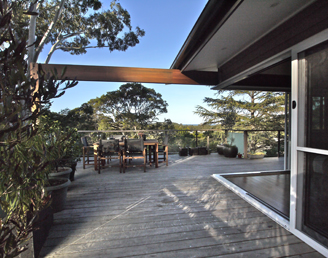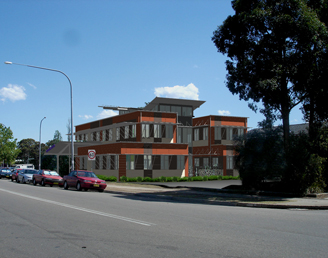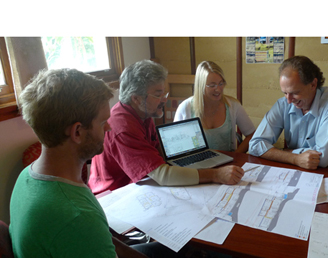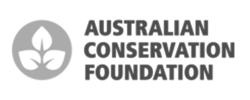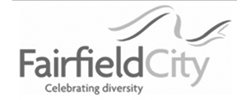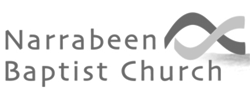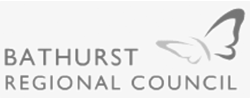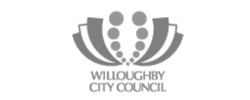Accoya instead of old growth hardwood
Posted by admin on 14/06/2023 at 4:33 pm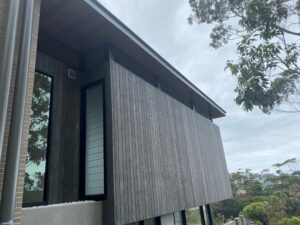
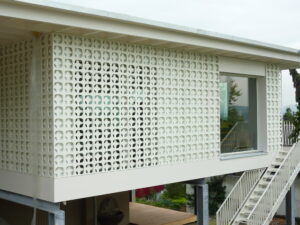 The world has used and loved Australian native hardwoods for over 200 years. While the London docks have benefited from its longevity in arduous conditions, as a result of sustained logging, land clearing, bushfire and now climate change, our koalas have had a less than ideal run at life.
The world has used and loved Australian native hardwoods for over 200 years. While the London docks have benefited from its longevity in arduous conditions, as a result of sustained logging, land clearing, bushfire and now climate change, our koalas have had a less than ideal run at life.
The Black Summer fires triggered an awakening of the fact that logging old growth forests (as distinct from plantations) has gone too far, and as a result most states have begun enacting some restrictions which need to be ramped up to stop old growth logging altogether. Many would argue with scientific authority that even this would be too little too late, but all agree the time has come to say enough is enough. All except communities whose economic wellbeing relies on old growth forestry – and we all agree they need support to make the transition to a sustainable economy.
Let’s look at the characteristics native hardwoods are valued for…
- Strength per unit of size – typical framing pine is strength rated at MGP10 or F7, compared to Ironbark at F42, which is approximately six times stronger. Ironbark is a standout, but even less ‘noble’ hardwoods are usually in the F17 to F34 range. Engineered timber increases this strength yet again, but that equally applies to lower rated softwoods, meaning that an engineered pine beam can compete with a solid sawn hardwood beam.
- Stability – many softwoods, and especially pinus species, are inherently susceptible to moisture ingress. Because their grain structure is open, any ambient water vapour or liquid water will cause the timber to grow across its cross section. Variations within the tree, or the sawing method during milling, can cause twisting and bowing. Not all hardwoods are immune from this either, but most are more stable once properly milled and dried. Any alternative must therefore be at least as stable.
- Longevity – resistance to insect attack, especially termites, is what sets most but not all hardwoods apart from nearly all softwoods. Several hardwood species are very susceptible, such as Tasmanian Oak (various ash species). Resistance to fungal decay (rot) is another feature of many hardwoods, which can make them suitable for external use, rated in durability classes from Class 4 for untreated pine to Class 1 for Ironbark and Huon pine.
- Fire resistance – in residential applications bushfire is the main fire risk we have to design for, and for the most part that means embers causing ignition on exposed surfaces. AS3959 Construction of buildings in bushfire prone areas contains a list of hardwoods that have been tested to resist ignition when exposed and uncoated, up to BAL-29. Six of the seven species listed are native hardwoods. Ideally we will find alternative products that rate as well or better than BAL-29.
A very good alternative to hardwoods in applications not requiring unprotected fire resistance is Accoya. Grown as pinus radiata in New Zealand, it undergoes treatment in the Netherlands that transforms it from a Class 4 species to the very top of Class 1 – possibly pipped for supreme champion only by that rare and much revered boat building timber from the wilds of west coast Tasmania, Huon pine. New Zealand is the source for Accoya because they grow big fat pine trees quickly, and it’s very straight and largely clear of knots.
The treatment is actually fairly simple in principle: the radiata’s cells are pumped full of a type of vinegar, which locks them up to external moisture. The technical name for the process is acetylation. It removes the usual pine problems at source; rather than treating wood with a toxic chemical trying to stop rot or insect attack and not helping with other water issues. The result is real non-toxic wood that doesn’t rot, doesn’t warp, swell or shrink, resists splintering, and is inedible to termites. It is so dimensionally stable that it’s perfect for painting and has outstanding durability.
The vinegar is acetic anhydride, and it catylises the acetylation process, but does not remain in the Accoya. It interacts with the wood molecules causing them to resist binding with water, and the liquid left over really is just strong vinegar. This by-product can be used in other industries, or reprocessed back for use again in the circular economy of the process.
Applications cover anything you would use hardwood (or softwood) for that does not involve uncoated fire resistance: decking, cladding, joinery windows and doors, boat-building, fencing, or large scale timber artworks. It also comes in ‘pre-aged’ finish, logically labelled ‘Accoya grey’ which looks fantastic in exposed decking and cladding applications.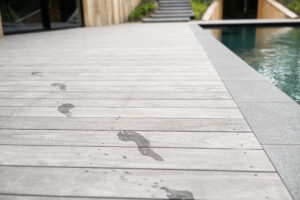
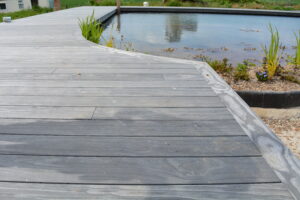
Because we like to try things out before unleashing them on clients, I undertook two smallish projects with Accoya: a new window and door unit with a high degree of exposure; and a new cabin on a 65 year old timber launch.
The window-door unit was made for me by H2 Custom Joinery in Warriewood NSW, who are also Accoya enthusiasts. They like its machinability, dimensional stability, that it takes a variety of coatings so well. Owner Nick Harley also introduced me to the MDF version of Accoya, cutely name Tricoya. He has had a piece lying outside his office in full sun and rain and in contact with ground moisture for many months, and it has not swelled or changed dimensions to any extent that he has been able to measure – pretty impressive. So we used Tricoya as the solid panel in the bottom of the Accoya door in an Accoya frame. After three months sun and rain the door or frame has not swelled or shrunk at all – zero movement.
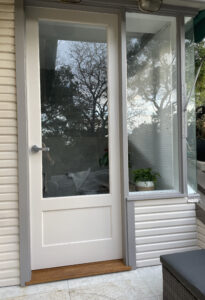
The boat was a project I decided on to soak up all my spare time (!). It was part of a larger scheme to replace the diesel engine with electric and solar panels. The old half cabin was not the original, didn’t suit the graceful lines of the hull, and certainly did not provide enough area for solar panels. So I drew on my long-past naval architectural training and designed a whole new cabin using Accoya framing and hoop pine plywood (in the absence of Accoya plywood).
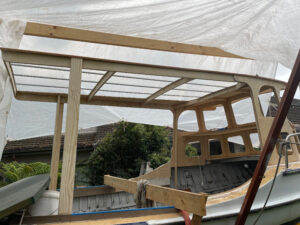 I found the Accoya easy to work with, it machines well, often coming off the fine rip saw needing only a light sand before painting. The thicknesser predictably produced a very fine surface finish. Laminated curved cabin-top beams were produced easily using bio-epoxy, and are very stiff and stable. Any epoxy will do, but bio-epoxy is made from canola oil, so – why not.
I found the Accoya easy to work with, it machines well, often coming off the fine rip saw needing only a light sand before painting. The thicknesser predictably produced a very fine surface finish. Laminated curved cabin-top beams were produced easily using bio-epoxy, and are very stiff and stable. Any epoxy will do, but bio-epoxy is made from canola oil, so – why not.
Having satisfied myself that Accoya is a perfectly viable alternative to hardwood in three out of four applications, I asked the question, why are we sending the raw timber from just over The Ditch, halfway around the globe to Europe for treatment, then bringing all the way back again? The local importer and distributor in Sydney is Britton Timbers, and their NSW manager Anthony Long explained that while there is an investment of a few million dollars in the necessary equipment, that is easily justified if the sales demand is there. Up until now Accoya has been specifed in very limited volumes, and is seen as a boutique timber.
I suggest that the recent moves to end old growth native forest logging, and the fact that Accoya is cheaper than western red cedar (that old staple of the joinery trade), as well as being more stable and resilient, mean its time has come. Let’s get specifying, the koalas will thank us.
The final word is to governments: we need to support the erstwhile logging communities to transition to a sustainable economy. Hands on resourcing is needed in all of the affected communities across Australia, so the tree fellers and machine operators become part of the drivers for a sustainable future, rather than economic discards, angry and disaffected. The koalas will thank them too.
Sustainable House Design
We will help you create a family home that works well, feels good, is kind to the environment, culturally appropriate and reduces your energy and running costs.
Read MoreSustainable Commercial Buildings
We design your building to help reduce your operating costs, optimize the life cycle of your building, increase your property value and increase employee productivity.
Read MoreWorking with Envirotecture
We design beautiful, sustainable buildings that work for you, your family or your business. Full range of building design, consulting and training services.
Read More
